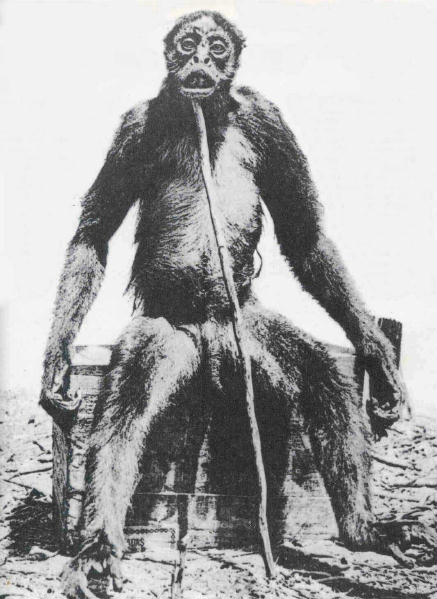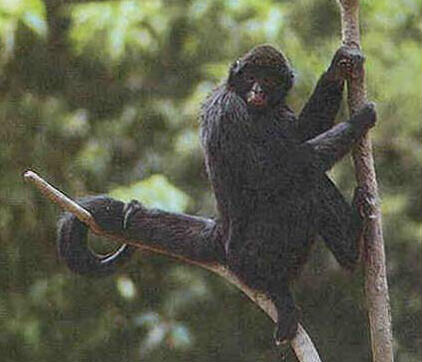Bigfoot
Encounters
Dr. Francois de Loys, de Loy's ape
Often spelled Deloys or DeLoy's
GIANT PRIMATES OF THE NEW WORLD
Alleged and true discoveries of large primates in South America
By Michael Seres, Yerkes Regional Primate Research Center
 Ameranthropoides
loysi, or Mono Rei:
Ameranthropoides
loysi, or Mono Rei:
Between 1917-1920, a Swiss geologist, named Dr. Francois de Loys and his men
were searching for oil around the River Tarra and Rio Catatumbo at the Venezuelan
- Colombian border in South America (Heuvelmans, 1959). This mountainous region,
the Sierra de Perijaa, was heavily forested, and that time was inhabited by
the 'dangerous' Motilone Indians.
One day, while de Loys and his crew were resting near the Tarra River deep
in the jungle, two monkeys suddenly stepped out of the woods, screaming and
shaking branches. They were holding onto bushes, walked upright then broke off
several branches, waving them like weapons. When the monkeys threw their own
excrement at the terrified de Loys and his exhausted companions, they grabbed
their guns and fired at the more aggressive-looking male, but killed the female.
The male stepped aside, though wounded, but disappeared in the forest.
Since de Loys, and his people have never seen such large monkeys, he wanted
to preserve the carcass. When finally de Loys returned home with the only remaining
evidence, the picture, which he had placed into his travel-notebook, he basically
forgot about his encounter with the unknown monkeys. Years later his friend,
French anthropologist Georges Montandon flipped the pages of de Loys' notebook,
and discovered the photo. Montandon got an idea.
Although Professor Montandon was familiar with most of the monkeys discovered
to that date, he had never seen one like that in de Loys' picture. Montandon
speculated that the large monkey on the picture was a very human-like creature.
It had no tail. Its size according to de Loys was 4 feet 5 inches. It had 32
teeth. It had all the features like the anthropoids in the Old World have and,
therefore must be an anthropoid Ape. Not just any Ape, but an 'American' Ape
-- a 'Missing Link!' He asked de Loys for more details, calculated some measurements
by estimating and comparing the size of the box with the body on the picture,
and in 1929, convinced de Loys to tell the story to the Illustrated London News
(Loys, 1929 op. cit.: Keith, 1929; Heuvelmans, 1959; Hill, 1962) Shortly therafter,
Montandon published his statement in the Journal de la Societe des Americanistes
(Montandon, 1929a); then wrote another note which he presented at the French
Academy of Sciences in Paris. (Montandon, 1929b). 'Montandon went so far as
to create a new genus Amer-anthropoides for the reception of the new animal,
giving it the specific name loysi in honor of its discoverer.' (Hill, 1962).
At the meeting of The French Academy of Sciences Montadon tried to present
some convincing 'evidence' about his major discovery of the American Ape, a
so far unknown 'American version' of the African chimpanzee and gorilla, and
the Asian orangutan. He and de Loys, - who under Montandon's pressure also tried
to support the new discovery hypothesis, - had to face with numerous questions
at the Academy. Naturalists and anthropologists questioned them very suspiciously.
They raised many questions about the photograph: the size of the monkey sitting
on the box, about her 'missing' tail, her set of only 32 teeth, her spider-monkey-like
face (Joleaud, 1929), her female sex organ - that resembled that of a male spider
monkey. (Female spider monkeys have a long, bulbous clitoris, that people, even
today often mistaken for the male sex organ).
 The
skepticism and some of the criticisms resulted in heated debates, often ridiculing
Montandon's alleged hypothesis as a fraud (Keith, 1929 op. cit.; Heuvelmans,
1959). When Montandon ran out of more convincing arguments in order to support
his fancy hypothesis, he tried to bring up some anecdotes based on stories of
Indian tribes like about the guayazi, the di-di, and the vasitri or 'big-devil'
that believed to attack women.
The
skepticism and some of the criticisms resulted in heated debates, often ridiculing
Montandon's alleged hypothesis as a fraud (Keith, 1929 op. cit.; Heuvelmans,
1959). When Montandon ran out of more convincing arguments in order to support
his fancy hypothesis, he tried to bring up some anecdotes based on stories of
Indian tribes like about the guayazi, the di-di, and the vasitri or 'big-devil'
that believed to attack women.
These stories were similar in nature, to those, that people were attributing
to gorillas in Africa (Heuvelmans, 1959). A. de Humboldt, who did not believe
any of these stories, attributed these alleged attacks to the spectacled bear
(Tremarctos ornatus) and Marquis de Wavrin mentions these creatures as 'marimunda'
which were later also identified as spider monkeys: Ateles belzebuth (Wendt,
1956; Heuvelmans, 1959; Hill, 1962).
Montandon was defeated in scientific circles, but the story created some ambiguity,
which led into more investigations for years to come, and in the mind of some,
even today, that there are still some large, yet mysterious creatures of several
kind, like Bigfoot, Yeti and Snowman still roaming the wilderness.
- ---
References:
Heuvelmans, B. (1959). ON THE TRACK OF UNKNOWN ANIMALS (Transl. from French
by Richard Garnett) Hill and Wang, New York
Hill, W. C. O., (1962). PRIMATES Comparative Anatomy and Taxonomy Vol. 5 Cebidae,
Part B. Edinburgh University Press
Joleaud, L. (1929) 'Remarques sur l'Evolution des Primates Sud-Americains, a
propos du Grand Singe du Venezuela' Rev. sci., Paris, pp. 269-273, 11 May 1929
Keith, Sir A. (1929) 'The Alleged Discovery of an Anthropoid Ape in South America'
Man (London) 29: 135-136. Loys, F. de (1929) 'A Gap filled in the Pedigree of
Man?' Illustrated London News, London, 15 June 1929, p. 1040
Montandon, G. (1929a) 'Decouverte d'un Singe d'Apparence Anthropoide en Amerique
du Sud' J. Soc. Americanistes Paris, n.s. 21
Montandon, G. (1929b) 'Singe d'Apparence Anthropoide en Amerique du Sud' C.
R. Acad. Sci. Paris, 11 March 1929
Wendt, H. (1956) NOE NYOMABAN Az allatok felfedezese - AUF NOAHS SPUREN Die
Entdeckung der Tiere by G. Grote sche Verlagsbuchandlung, Hamm. (Westf.) [Transl.
from German by Auer Kalman, 1972] Gondolat, Budapest, Hungary
© http://www.primate.wisc.edu/pin/monorei.html
Primate Center, Wisconsin University
Bobbie Short
 Ameranthropoides
loysi, or Mono Rei:
Ameranthropoides
loysi, or Mono Rei:  The
skepticism and some of the criticisms resulted in heated debates, often ridiculing
Montandon's alleged hypothesis as a fraud (Keith, 1929 op. cit.; Heuvelmans,
1959). When Montandon ran out of more convincing arguments in order to support
his fancy hypothesis, he tried to bring up some anecdotes based on stories of
Indian tribes like about the guayazi, the di-di, and the vasitri or 'big-devil'
that believed to attack women.
The
skepticism and some of the criticisms resulted in heated debates, often ridiculing
Montandon's alleged hypothesis as a fraud (Keith, 1929 op. cit.; Heuvelmans,
1959). When Montandon ran out of more convincing arguments in order to support
his fancy hypothesis, he tried to bring up some anecdotes based on stories of
Indian tribes like about the guayazi, the di-di, and the vasitri or 'big-devil'
that believed to attack women.